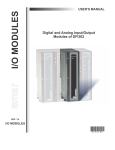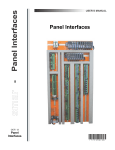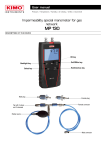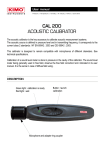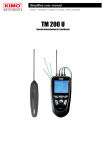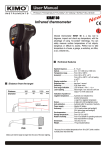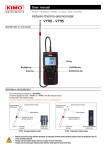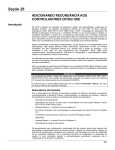Download DF 110 - kimo instruments uk
Transcript
DF 110 Detector of refrigerant gases and hydrogen (H2) DESCRIPTION OF THE DEVICE Batteries led Autozero led Leds of graphic visualisation of thresholds Activation / deactivation key for the audible signal On/Off key Sensitivity/Manual autozero key PERFORM A MEASUREMENT Turn on the detector pressing the “On/Off” key. When it turns on, the pre-heating phase of the sensor begins. This phase lasts 60 seconds. During this phase, all the visualisation leds of thresholds light one after the other. A few second before the end of the pre-heating phase, all the leds blinks at the same time. ➢ Place the probe as close as possible to the site of the suspected leak. ➢ Slowly move the probe (approximately 2 cm/second) in the direction to the possible source of the leak. It is important to move the probe past the leak and to go back toward it. The device responds to changes in gas concentration in the air. Moving the probe allows to the device to respond properly to these changes. ➢ If gas is detected, the frequency of the beep repetition will increase as the detected gas concentration increases and the leds of graphic visualisation lights from the left (low gas concentration) to the right (high gas concentration). ➢ Manual and automatic autozero functioning The detector performs an automatic autozero every 2 s to set its minimum threshold of detection. This autozero allows to guarantee an optimum gas detection whatever the conditions of use (contaminated environment, temperature variations,...). In case of detection, according to the amplitude of gas measurement, the automatic autozero will deactivate to guarantee a better location of the leak. It will automatically reactivate after a return to normal conditions. In case of high gas concentration with a wide contaminated area, the automatic autozero can be not enough to detect precisely the location of the leak, there will be a measurement saturation. In this case, it is possible to perform a manual autozero into the contaminated area to reset the detection and to get back to a progressive sensitivity when getting close to the leak source. To perform a manual autozero, please see next page. Setting of the sensitivity If the gas concentration is high, press “Sens” key to set the sensitivity and like this to get a better identification of the leak source. Please see next page for the details about the three different sensitivities. ADJUST THE DEVICE Adjust the sensitivity Press the “Sensitivity/Autozero” key to adjust the sensitivity of the device. Mode Indicative measuring range (g/an) Visual alarm Low sensitivity ( “B” on the device) From 0 to 300 g/an All the leds (8) for 300 g/an Normal sensitivity (“Norm” on the device) From 0 to 30 g/an All the leds (8) for 30 g/an High sensitivity (“H” on the device) From 0 to 3 g/an All the leds (8) for 3 g/an Activate/deactivate the audible signal By default, when starting the device, the audible signal is always active. ➢ ➢ The device is turned on. Press key to activate the audible signal. Press this same key to deactivate it. Perform an autozero ➢ The device is turned on. Press at least 3 s the key to perform an autozero. The “Autozero” led turn on. CHANGE THE BATTERIES Remove the front part at the back of the device. Change the old batteries by AAA LR03 1.5V batteries. ➢ Replace the front part. ➢ ➢ Once returned to KIMO, required waste collection will be assured in the respect of the environment in accordance to 2002/96/CE guidelines relating to WEEE NTang – portable-DF110 – 26/06/14 – RCS (24) Périgueux 349 282 095 Non-contractual document – We reserve the right to modify the characteristics of our products without prior notice. ➢


